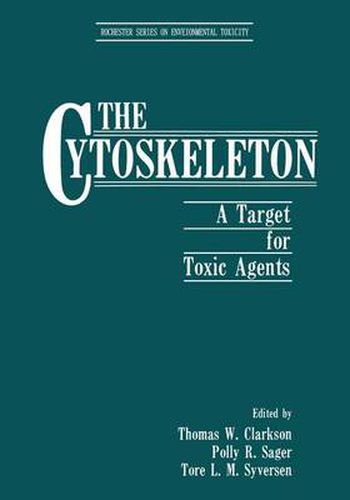Readings Newsletter
Become a Readings Member to make your shopping experience even easier.
Sign in or sign up for free!
You’re not far away from qualifying for FREE standard shipping within Australia
You’ve qualified for FREE standard shipping within Australia
The cart is loading…






This book is based on reviews and research presentations given at the 16th Rochester International Conference on Environmental Toxicity, entitled liThe Cytoskeleton: A Target for Toxic Agents, held on June 4, 5 and 6 in 1984. The conference provided an in-depth discussion of the effects a~d mechanism of action of some toxic agents on the cytoskeleton. Mamma lian and other eukaryotic cells contain protein networks within the cytoplasm comprised of microfilaments, intermediate Hlaments and microtubules. These components of the cytoskeleton playa key role in cell shape, motility, intracellular organization and transport, and cell division. Furthermore, the cytoskeleton, via associations with the cell membrane, appears to function in intracellular communication and cellular responses to membrane events. Because of the complex functional roles of the cytoskeleton which vary with cell type, degree of differentiation, and cell cycle, its disruption may result in a variety of cellular changes. This expanding field in cell biology has already attracted the interest of toxicologists and environmental health scientists as a potentially fruitful area of research. Indeed, there is mounting evidence that certain toxic and chemotherapeutic compounds, as well as physical agents such as radiation and hydrostatic pressure, disrupt the normal structure and function of the cytoskeleton. This may be an important step in the overall expression of their action. It was, therefore, an opportune time to hold a conference to encourage the development of this area of toxicology and to suggest directions for future research.
$9.00 standard shipping within Australia
FREE standard shipping within Australia for orders over $100.00
Express & International shipping calculated at checkout
This book is based on reviews and research presentations given at the 16th Rochester International Conference on Environmental Toxicity, entitled liThe Cytoskeleton: A Target for Toxic Agents, held on June 4, 5 and 6 in 1984. The conference provided an in-depth discussion of the effects a~d mechanism of action of some toxic agents on the cytoskeleton. Mamma lian and other eukaryotic cells contain protein networks within the cytoplasm comprised of microfilaments, intermediate Hlaments and microtubules. These components of the cytoskeleton playa key role in cell shape, motility, intracellular organization and transport, and cell division. Furthermore, the cytoskeleton, via associations with the cell membrane, appears to function in intracellular communication and cellular responses to membrane events. Because of the complex functional roles of the cytoskeleton which vary with cell type, degree of differentiation, and cell cycle, its disruption may result in a variety of cellular changes. This expanding field in cell biology has already attracted the interest of toxicologists and environmental health scientists as a potentially fruitful area of research. Indeed, there is mounting evidence that certain toxic and chemotherapeutic compounds, as well as physical agents such as radiation and hydrostatic pressure, disrupt the normal structure and function of the cytoskeleton. This may be an important step in the overall expression of their action. It was, therefore, an opportune time to hold a conference to encourage the development of this area of toxicology and to suggest directions for future research.